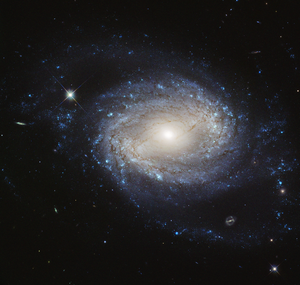NGC 4639
| Galaxie NGC 4639 | |
|---|---|
 | |
| Aufnahme des Hubble-Weltraumteleskops | |
| AladinLite | |
| Sternbild | Jungfrau |
| Position Äquinoktium: J2000.0, Epoche: J2000.0 | |
| Rektaszension | 12h 42m 52,4s[1] |
| Deklination | +13° 15′ 27″[1] |
| Erscheinungsbild | |
| Morphologischer Typ | SAB(rs)bc / Sy1.0[1] |
| Helligkeit (visuell) | 11,4 mag[2] |
| Helligkeit (B-Band) | 12,2 mag[2] |
| Winkelausdehnung | 2,9' × 2,0'[2] |
| Positionswinkel | 123°[2] |
| Flächenhelligkeit | 13,2 mag/arcmin²[2] |
| Physikalische Daten | |
| Zugehörigkeit | Virgo-Cluster Messier 87-Gruppe NGC 4639-Gruppe NGC 4486-Gruppe LGG 289[1][3] |
| Rotverschiebung | 0.003395 ± 0.000018[1] |
| Radialgeschwindigkeit | (1018 ± 5) km/s[1] |
| Hubbledistanz H0 = 73 km/(s • Mpc) | (43 ± 3) · 106 Lj (13,3 ± 0,9) Mpc [1] |
| Durchmesser | 45.000 Lj |
| Geschichte | |
| Entdeckung | Wilhelm Herschel |
| Entdeckungsdatum | 12. April 1784 |
| Katalogbezeichnungen | |
| NGC 4639 • UGC 7884 • PGC 42741 • CGCG 070-230 • MCG +02-32-189 • IRAS 12403+1331 • 2MASX J12425235+1315271 • VCC 1943 • GC 3173 • H II 125 • h 1403 • HIPASS J1243+13a • LDCE 904 NED233 | |
NGC 4639 ist eine Balken-Spiralgalaxie mit aktivem Galaxienkern vom Hubble-Typ SBbc im Sternbild Jungfrau nördlich der Ekliptik. Sie ist schätzungsweise 43 Millionen Lichtjahre von der Milchstraße entfernt und hat einen Durchmesser von etwa 35.000 Lichtjahren. In ihrem äußeren Bereich können Cepheiden beobachtet werden. Unter der Katalognummer VVC 1943 wird sie als Mitglied des Virgo-Galaxienhaufens gelistet.
Im selben Himmelsareal befinden sich u. a. die Galaxien NGC 4611, NGC 4620, NGC 4654, NGC 4659.
Die Typ-Ia-Supernova SN 1990N wurde hier beobachtet.[4]
Das Objekt wurde am 12. April 1784 von dem deutsch-britischen Astronomen Wilhelm Herschel entdeckt.[5]
Weblinks
- Elegant spiral hides a hungry monster (engl.)
- SIMBAD Astronomical Database
- Hubble-Weltraumteleskop
- astronews.com: Bild des Tages 13. Oktober 2015
Einzelnachweise
Auf dieser Seite verwendete Medien
Autor/Urheber: Judy Schmidt, Lizenz: CC BY 2.0
Surprisingly, only a WFPC2 version of this galaxy is <a href="http://hubblesite.org/newscenter/archive/releases/1996/21/image/b/" rel="nofollow">featured</a> on the Hubble sites. This is a combination of WFC3 and ACS data. It's not quite as deep as the WFPC2 observations but it's still a lovely set of data.
Red: hst_11570_23_wfc3_uvis_f814w_sci Green: hst_11570_23_wfc3_uvis_f350lp_sci Blue: HST_10802_86_ACS_WFC_F555W_sci
Various other data was (were?) used to fill in the chip gap. I did something strange this time, too. I rotated the diffraction spikes for the blue channel so that they would match with the other two channels. There were only three stars this time so it wasn't a big deal to do. I don't know about other people but one of the more obscure things which please me are the subtle, rainbow-like spectrums visible in some diffraction spikes.
North is NOT up. It is 58° clockwise from up.